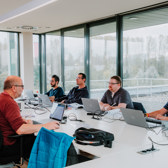Managing a Power BI Environment
UPBIM
3 days
Interested in a private company training? Request it here.
Not ready to book yet? Request an offer here.
Introduction to Enterprise Power BI
Overview of Power BI usage scenarios, collaboration methods, enterprise capabilities, and the importance of managing the Power BI Service, including pricing.
- Power BI Usage Scenarios
- Power BI Service Pricing
- The Power BI Architecture
- LAB: Diving into the Power BI Architecture
Configuring Workspaces
Workspaces are places where users collaborate to create semantic models, reports, dashboards, data flows, ... In this module students will learn about securing and managing workspaces in an enterprise Power BI environment. Topics like how to automate the creation of workspaces and assigning capacity will be covered in this chapter.
- Creating Workspaces
- Configuring Workspace - OneDrive Synchronization
- Workspace Connectivity with the XMLA Endpoint
- Managing Workspaces with PowerShell
- LAB: Configuring Workspaces
Creating and Managing Semantic Models
Semantic Models are at the cornerstone of Power BI reporting. This module covers the development and versioning of reusable semantic models using free and open-source tools.
- Working with Semantic Models in the Power BI Service
- Power BI Projects and Source Control
- Git Integration in the Power BI Service
- Adjusting and Deploying Semantic Models with Tabular Editor
- Versioning and Deploying using ALM Toolkit
- Aggregations in Semantic Models
- Semantic Model Deployment using PowerShell
- LAB: Deploying and Versioning Semantic Models
Configuring Workspace Security
This module discusses the different workspace security roles and the consequences of these roles when sharing dashboards and reports with other users.
- Configuring Workspace Security
- Security when Sharing Dashboards and Reports
- Row-Level and Object-Level Security
- Securing Data at Rest
- Securing Data in Transit
- LAB: Securing Workspaces
Refreshing Semantic Models
This chapter talks about the importance of scheduling data refreshes in Power BI to keep reports up-to-date. It covers incremental refresh and to efficiently manage large datasets, and explains how data gateways enable secure refreshes for on-premise data sources.
- Refreshing Online vs On-Prem Data Sources
- Configuring Data Refresh Credentials
- Configuring and Monitoring Data Gateways
- Scheduling Refreshes
- Configuring Incremental Refresh
- Improving Refresh Performance with Query Folding
- LAB: Configuring Data Refreshes
Deploying Content using Deployment Pipelines
When Power BI reports and dashboards become essential company resources, you don't want to deploy new or updated workspace content directly in a production workspace. This module describes how to use deployment pipeline to deploy workspace content between development, acceptance and production workspaces to so proper Application Lifecycle Management can be applied.
- The Need for different Workspaces
- Configuring Deployment Pipelines
- Using Deployment Pipelines for reporting ALM
- Getting the Most out of Deployment Pipelines
- LAB: Working with Deployment Pipelines
Working with Dataflows
Dataflows bring Power Query to the cloud, allowing the reuse of data preparation logic in multiple semantic models or in other Azure technologies. In this module, we will discuss the concept and usage of dataflows and the Common Data Model. You will not only learn how dataflows are created and leveraged in Power BI, but also how they can be used in other Microsoft Azure technologies like Azure Synapse and Databricks using Spark and the Common Data Model connector.
- Dataflows, Entities and the Common Data Model (CDM)
- Dataflows and Azure Data Lake Gen 2 Storage
- Working with Linked and Computed Tables
- Scheduling Refreshes for Dataflows
- Using Dataflows in Power BI Desktop
- Dataflow Licensing
- LAB: Working with Dataflows
Monitoring Power BI
Monitoring the Power BI Service is crucial to spot performance issues and to estimate capacity. Auditing is also important from a security point of view.
- Using the Admin Monitoring Workspace
- Monitoring Workspace Usage
- Customizing Workspace Usage Reports
- Power BI Premium Capacity Metrics and Alerts
- Power BI Activity Log for Advanced Logging
- Unified Microsoft 365 Audit Logging
- LAB: Monitoring the Power BI Service
Administering a Power BI Tenant
To enforce company policies, tenant settings need to be properly configured. Which custom visuals can be used? Can reports and report data be shared with external users, ... In this module you will get an overview of the different Power BI tenant settings you can configure.
- Tenant Settings Overview
- Configuring Tenant Settings
- Tenant Settings Best Practices
- Sharing Settings
- Custom Visuals Settings
Power BI is a suite of business analytics tools designed to analyze data and share insights. This training focuses on setting up and managing Power BI in an enterprise environment, addressing challenges such as versioning, data lineage, deploying large semantic models, and security.
BI and IT professionals responsible for deploying and managing Power BI solutions in the cloud at an enterprise level. Some prior experience with Power BI Desktop is expected but not required.









